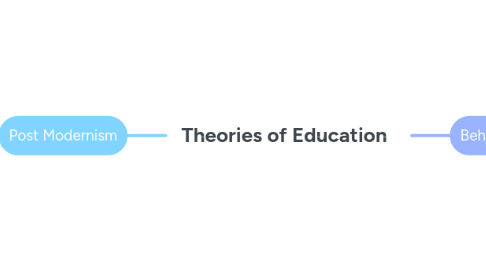
1. Behaviorism
1.1. The basic principle of behaviorism is that education can best be achieved by modifying or changing student behaviors in a socially acceptable manner through the arrangement of the conditions for learning.
1.2. Purpose of Schooling
1.2.1. To modify or change student behaviors that are unwanted by using rewards and punishments. Focusing on the student knowing of predetermined rewards and punishments.
1.3. Nature of the Learner
1.3.1. Students are passive learners who are taught. Through reinforcement and conditioning they are shaped to behave a certain way. Major focus on the ability of behavior to be changed.
1.4. Instructional Methods
1.4.1. The Instructional Methods include putting processes in place to reinforce behavior as the primary strategy for education. Particular focus on technologies that are interactive and provide immediate feedback. “Other instructional methods employed by behaviorists include strategies such as problem solving, anger control, self-instruction, and self-reinforcement training.”(Webb, Metha, Pg 81)
1.5. Curriculum
1.5.1. “The behaviorist curriculum would be based on well-prepared behavioral objectives and would include cognitive problem-solving activities in which students learn about their belief systems, recognize their power to influence their environment, and employ critical thinking skills.” (Webb, Metha, Pg 81)
1.6. Classroom Management
1.6.1. Major focus on teachers identifying terms that will be consistently used. Communicating desired behaviors, undesired behaviors and maintaining rewards and punishments to the student as they perform tasks and behaviors. Teachers need to be organized and keep applying appropriate reward/consequence to behaviors. Highly structured, task oriented classroom.
1.7. Assessment Strategies
1.7.1. Behavioral objectives that students can demonstrate to prove learning. Measurement and evaluation are used to assess if the teacher is reaching their goals.
1.8. Role of the Teacher
1.8.1. Skills for a behaviorist teacher will include technical and observational skills. Understanding of psychological principles within education will be a helpful skill as well. Taking in all behaviors and applying the correct response to the behavior is the core element. Having
1.9. Usefulness to your own classroom
1.9.1. I chose Behaviorism as it is a good tool to use for students that do not thrive in the current occurring classroom. I also feel that the younger this style of teaching gets used, the better off they will be. I will use this type of teaching for the students with IEP or that are struggling with the normal curriculum.
2. Post Modernism
2.1. Postmodernists believe that there are no eternal universal truths and values. They suggest that reality is subjective; it is not found in our ancient past, but in the mind of the beholder..(Webb, Metha, Pg 90)
2.2. Purpose of Schooling
2.2.1. To encourage active learning and the attainment of knowledge through experiences, trying thing out and coming to their own conclusions. Resulting in critical thinkers and reflective personalities.
2.3. Nature of the Learner
2.3.1. Students are active participants in the process of learning. They make conclusions based off their prior experiences and interactions.
2.4. Instructional Methods
2.4.1. Focuses on group discussion, collaborative learning, hands-on activities and problem based learning. Teachers act as instigators, getting students on the right track then answering questions and giving feedback.
2.5. Curriculum
2.5.1. The curriculum for a postmodernist teacher is more open ended and allows for students to make their own discoveries within their learning. Focusing on real problems will encourage students to think abstractly, improving their skills.
2.6. Classroom Management
2.6.1. This classroom has an environment that is student centered and interactive. Changing seating arrangements will help students hear from other perspectives. Teachers push for autonomy and will put responsibility of learning more on students than other theories.
2.7. Assessment Strategies
2.7.1. Assessments will be carried out by teachers in a myriad of different ways. Assessments will cover the ability to apply knowledge to problems faced in class. They will also have different avenues to submit their works such as projects, papers, presentations and peer evaluations.
2.8. Role of the Teacher
2.8.1. “The postmodernist teacher’s role is to practice and model the “doing of critical theory.” These teachers practice and model questioning, critiquing, and analyzing. At the same time, they recognize the power and influence they have over their students and their students’ peers, parents, and the larger community.” (Webb, Metha Pg 92) Teachers are in constant communication with others and their students to ensure they are getting the most out of their lessons.
2.9. Usefulness to your own classroom
2.9.1. I chose postmodernism because it was in a class like this that I learned the most. The movement within learning and in the class kept me fresh and ready to learn more. I love that it empowers students to pursue their own education in the way that works for them.
